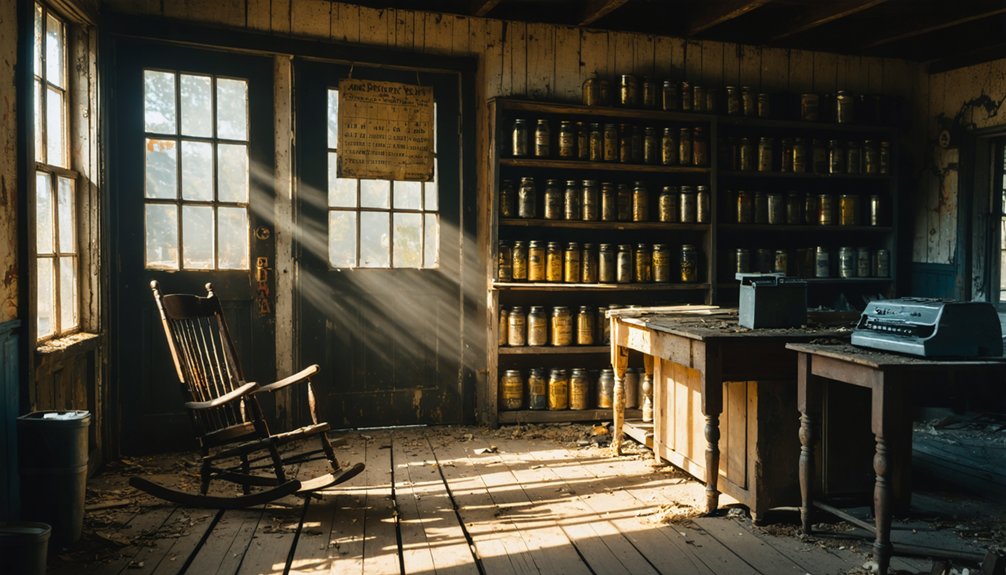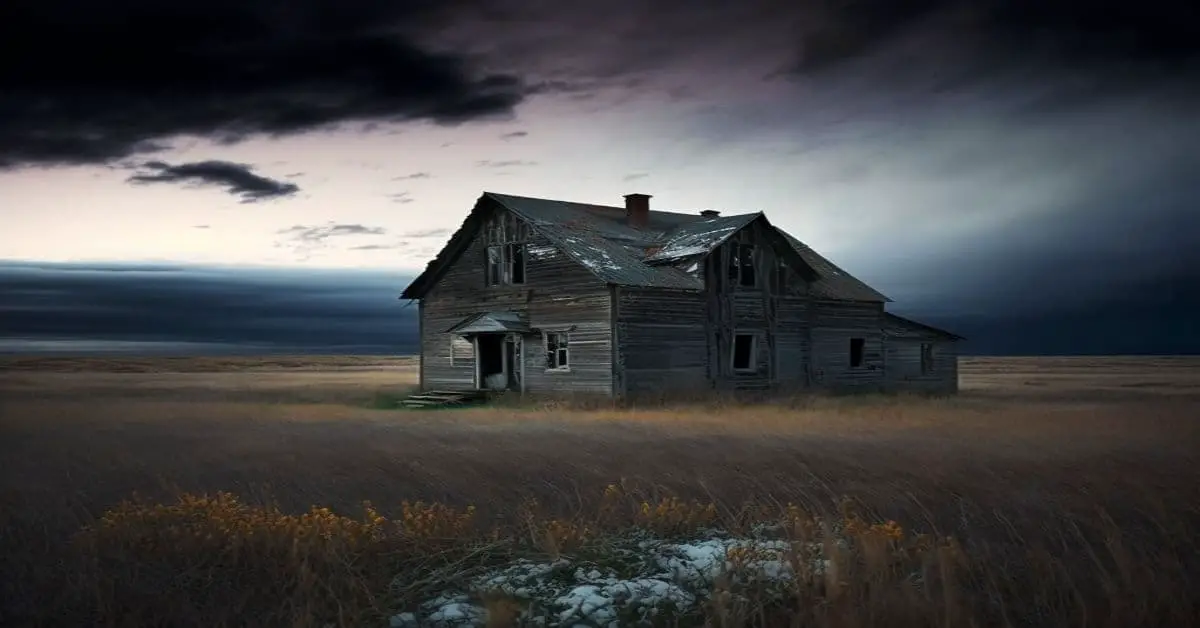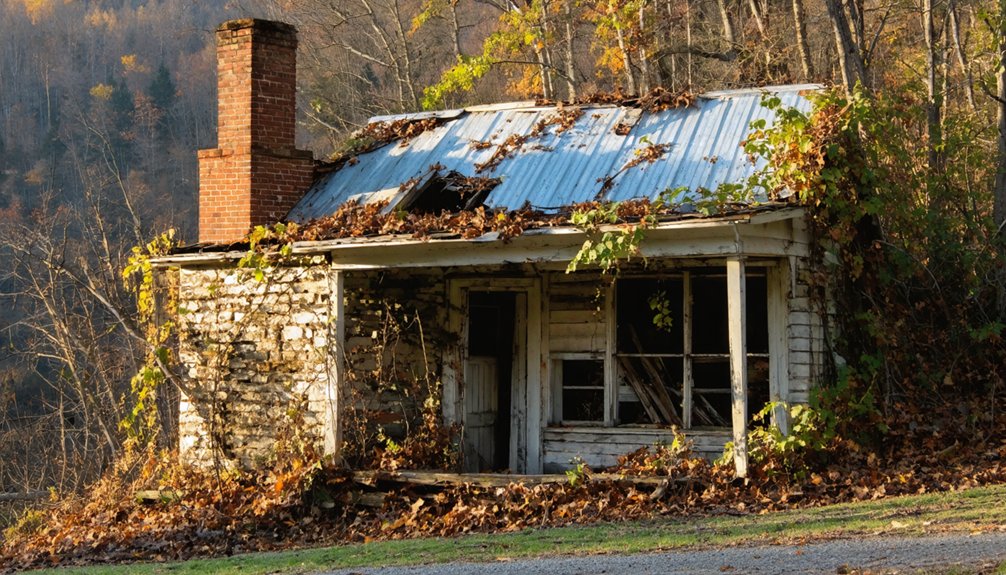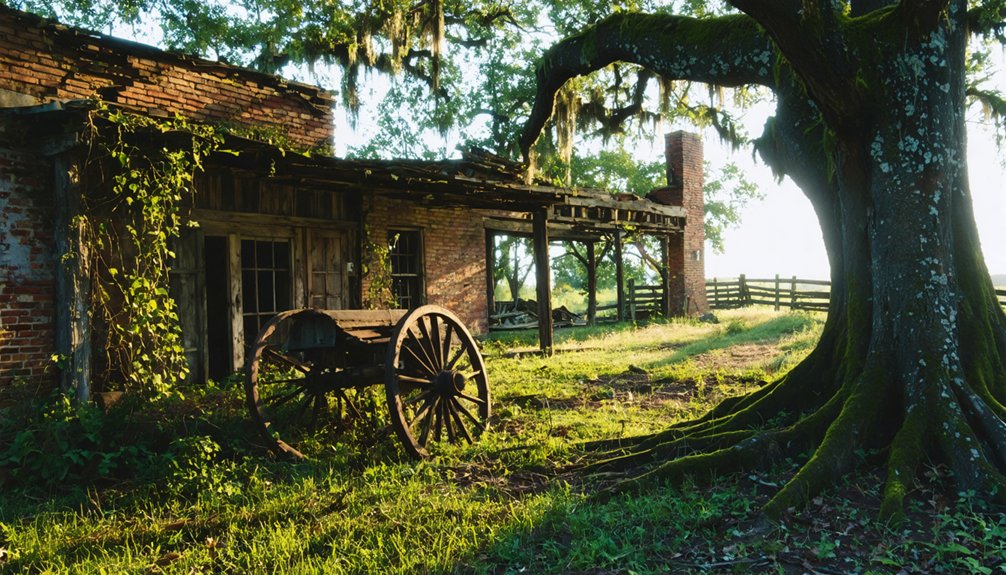You’ll find Sneed’s ghostly remains in Arkansas, where a once-thriving farming community met its tragic end on April 10, 1929. Founded in 1820 by William Sneed, this close-knit settlement flourished with grist mills, farms, and a wooden church until an F5 tornado with 318 mph winds devastated the area, claiming 23 lives. Today, the site serves as both a memorial to rural resilience and a sobering reminder of nature’s raw power. The stories of survival and loss still echo across these empty fields.
Key Takeaways
- Sneed, Arkansas was established in 1820 by William Sneed and developed into a thriving farming community with essential infrastructure and businesses.
- The town’s economy centered around agriculture, utilizing rich Memphis silt loam soil for crops like corn, wheat, and soybeans.
- An F5 tornado with 318 mph winds struck Sneed on April 10, 1929, destroying the town’s buildings and killing 23 people.
- The devastating tornado left only a clearing where the town’s school and church once stood, effectively ending the community’s existence.
- Today, Sneed exists as a ghost town, remembered primarily for experiencing Arkansas’s only recorded F5 tornado in 1929.
The Birth of a Rural Farming Community
While many Arkansas settlements emerged organically through gradual migration, the town of Sneed began with William Sneed’s purposeful vision in 1820. Coming from Kentucky, he first surveyed the land and planted corn to establish his claim before bringing his family and enslaved workers to the Ozarks.
The community origins took shape as pioneer settlers, primarily from Tennessee and Kentucky, followed Sneed’s lead. By 1830, William and his son Charles had claimed thousands of acres in Osage Township. Like many early settlers, they established log homes and farms as they built their new lives in the region.
The Sneed family home became a hub of civic life, hosting court proceedings while Charles served as both sheriff and postmaster of the growing settlement. The town would later face complete devastation when an F5 tornado struck in 1929, forever altering its future.
You’ll find the town’s early development centered around essential farming activities, with settlers clearing fields and establishing supportive businesses like grist mills, tanneries, and trading posts.
Life Before the Storm
If you’d visited Sneed in its early days, you’d have found a close-knit farming community centered around its wooden church and schoolhouse, where families gathered regularly for worship and education.
The town’s residents sustained themselves through crop cultivation and livestock raising on family farms passed down through generations, with neighbors supporting one another during both prosperous and challenging times. Local historical records show that the surname-holder lists helped track the town’s prominent farming families through multiple generations.
Daily life revolved around agricultural schedules and community events, as families maintained strong social bonds through shared activities at church functions, school programs, and cooperative farm work.
Rural Community Foundations
Before storms forever changed Sneed’s destiny, this rural Arkansas community flourished through the determined efforts of its earliest settlers.
The community dynamics centered around William Sneed and his son Charles, who claimed thousands of acres in Osage Township around 1830. They established essential infrastructure, including the region’s first major road connecting Lead Hill to Carrollton.
You’d have found a vibrant mix of social cohesion among Native Americans, white settlers from Tennessee and Kentucky, and enslaved workers who together shaped the area’s development.
The community supported thriving businesses like grist mills, tanneries, and trading posts. Local homes served multiple purposes, hosting both court sessions and social gatherings, while Charles Sneed’s civic leadership as sheriff and postmaster helped establish governmental foundations that would serve the growing settlement.
Agricultural Heritage Roots
Throughout the agricultural heyday of Sneed, you’d have seen vast fields of corn, wheat, and soybeans stretching across the fertile Arkansas soil, punctuated by grazing cattle and working horses that defined the region’s mixed farming operations.
The community’s resilience stemmed from smart crop rotation practices and diversified farming that sustained both people and livestock. At the heart of this agricultural empire stood the Sneed family, whose large-scale farming operations shaped the local economy. Their influence extended beyond crops, helping establish essential community anchors like the Sneed Church and School. The farmland’s success relied heavily on the rich Memphis silt loam soil. The area’s abundance of limestone deposits provided natural building materials for many local structures.
Before mechanization transformed farming, manual labor drove the harvests, with families working together through seasonal demands. These agricultural roots created a self-sufficient community where barns, storehouses, and storm cellars protected both crops and residents.
Daily Life Patterns
Life in Sneed revolved around the rhythms of rural Arkansas, where the interplay between farming duties and community bonds shaped each passing day. You’d find families tending their crops and livestock from sunrise to sunset, with daily routines centered around the church and schoolhouse that stood side by side.
During peak farming seasons, neighbors would join forces for planting and harvesting, while children balanced their education with agricultural responsibilities.
The community’s heart beat strongest during church gatherings and social events, where multiple generations came together under wooden roofs or open skies.
You’d witness the spirit of self-reliance as folks traveled dusty roads by foot or wagon, communicating news through personal visits and shared meals, creating an intricate web of support that defined Sneed’s character.
The F5 Tornado of April 10, 1929
A devastating F5 tornado, the most powerful ever recorded in Arkansas history, struck the town of Sneed and surrounding communities on April 10, 1929. With wind speeds reaching up to 318 mph, the half-mile-wide twister exhibited extreme tornado intensity as it carved through Independence and Jackson counties, leaving catastrophic destruction in its wake. The tornado completely destroyed Guion, leaving only four buildings standing.
The storm nearly erased Sneed and Pleasant Valley from existence, claiming 23 lives in Jackson County alone and injuring 59 others. Entire families, like the Nicholsons and DeFries, suffered heart-wrenching losses. The National Guard was deployed to assist in the recovery efforts.
The tornado’s multiple-vortex structure scattered debris so widely that community rebuilding efforts were severely hampered by blocked roads and heavy rains. Without tornado insurance, many residents faced overwhelming financial burdens. Those who survived often found refuge in storm cellars, barns, and even chicken houses.
Tales of Survival and Loss

When the devastating F5 tornado approached Sneed in 1929, you’ll find that many families sought refuge in their storm cellars and root cellars, which served as critical underground shelters during those terrifying moments.
You’ll discover heartbreaking accounts of entire families who lost everything they owned, including their homes, barns, and livestock, while some families suffered even greater losses of loved ones.
Yet, you’ll also encounter remarkable stories of survival, including accounts of residents who emerged from their cellars to find their homes completely destroyed but their families miraculously spared.
Seeking Shelter Underground
Through the darkening skies of April 10, 1929, residents of Sneed and Pleasant Valley faced nature’s ultimate fury as an F5 tornado bore down on their communities.
When you look back at their storm preparedness, you’ll find that survival depended on quick thinking and available shelter. As the half-mile-wide twister approached with winds up to 318 mph, people scattered to whatever refuge they could find – storm cellars, road bridges, barns, and even chicken houses.
Their community resilience was tested as the violent winds swept entire homes away, hurling debris over 50 miles. Today, only a clearing remains where the town’s cherished school and church buildings once provided education and spiritual comfort to local families. While 23 souls were lost that day, many others survived thanks to their split-second decisions to seek underground shelter.
The makeshift morgue in Swifton stood as a grim reminder of those who couldn’t find adequate protection in time.
Family Stories of Loss
Inside the heart-wrenching aftermath of the 1929 tornado, personal stories of devastating loss emerged from both Sneed and Pleasant Valley’s tight-knit farming communities.
You’ll find tales of family resilience in the face of unimaginable tragedy, like the Charles DeFries family who lost four members when their home was demolished.
In the Nicholson home, twelve people desperately fled room to room as the structure collapsed around them, leading to multiple deaths.
Community mourning reached its peak as survivors emerged to identify loved ones at a makeshift morgue in Swifton.
The tornado’s brutal force shattered entire households in minutes, leaving survivors to rebuild their lives elsewhere.
These stories of loss have been preserved through generations, marking a defining moment in Jackson County’s history.
Miracle Survival Cases
Amidst the devastating F5 tornado that struck Sneed in 1929, remarkable stories of survival emerged from those who found refuge in unconventional shelters.
You’ll find tales of residents who sought protection in storm cellars, under road bridges, and even in chicken houses – miracle shelters that proved life-saving during Arkansas’s only recorded F5 tornado.
Despite heavy rains and muddy conditions hampering rescue efforts, the community’s resilience shone through as they worked together to save lives.
Survivors described the tornado as a “gigantic hand” that swept through their farm communities, forcing some to flee from room to room as their homes crumbled.
While Sneed and Pleasant Valley were almost completely destroyed, these stories of survival demonstrate the remarkable human spirit and resourcefulness that emerged during one of Arkansas’s most catastrophic natural disasters.
The Immediate Aftermath

When the F5 tornado devastated Sneed and Pleasant Valley on April 10, 1929, it left behind unprecedented destruction that would permanently alter the region’s landscape.
The community’s immediate disaster response faced overwhelming challenges, as heavy rains turned roads to mud while massive timber debris blocked access to the affected areas. You’ll find that local residents showed remarkable community resilience, conducting initial rescue efforts despite severely limited resources.
A makeshift morgue in nearby Swifton processed the 23 victims, while survivors grappled with severe injuries and the loss of entire families.
The Charles DeFries family lost four of their eight members when their home was destroyed. With Sneed Church and School obliterated, along with most homes and farm buildings, the catastrophic damage ultimately led to the community’s abandonment.
What Remains Today
Today at the former site of Sneed, Arkansas, you’ll find little evidence that a vibrant rural community once existed there.
The site conditions reflect complete abandonment, with nature having reclaimed the land where Sneed Church and School once anchored the community. You won’t see any historical markers, monuments, or remnants of roads or buildings that might commemorate this lost town. Much like nearby Okay, Arkansas, where only one church building remains standing, time has erased most traces of human settlement.
The coordinates (35°52′22″N 91°06′50″W) will lead you to an open clearing in Jackson County, but natural reclamation has transformed the landscape into an undisturbed wildlife habitat. Much like the Windyville ghost town, this area has become a silent testament to Arkansas’s forgotten communities.
Grasses and vegetation now blanket the Black River bottoms where the town stood before the devastating F5 tornado of 1929. The site remains unmarked and peaceful, preserving only the quiet memory of a community that once called this place home.
Legacy in Arkansas History

The legacy of Sneed, Arkansas extends far beyond its physical ruins, serving as a powerful tribute to both human resilience and nature’s destructive force.
You’ll find this small farming community’s story woven into the fabric of Arkansas’s historical preservation efforts, particularly as the site of the state’s only recorded F5 tornado in 1929.
The town’s tragic end has become a crucial case study in community resilience, teaching valuable lessons about disaster preparedness and response in rural areas.
The destruction of Sneed forced us to rethink how rural communities prepare for and recover from devastating natural disasters.
While Sneed no longer exists physically, its memory lives on through survivor accounts, meteorological research, and educational materials.
You’ll see references to Sneed in state historical records, where it stands as a sobering reminder of how natural disasters can permanently alter rural communities’ destinies.
Frequently Asked Questions
Were There Any Native American Settlements in Sneed Before William Sneed Arrived?
While Native American historical settlements existed nearby, you’ll find no documented evidence of specific settlements within Sneed’s boundaries, though Delaware, Shawnee, and Cherokee peoples likely traversed the area.
What Crops Were Primarily Grown by Farmers in Sneed?
You’ll find farmers primarily grew cotton, soybeans, corn, and rice, implementing crop rotation practices. Cotton farming dominated early on, but they shifted toward soybeans and rice after the 1950s for better profits.
How Many Students Typically Attended Sneed School Before the Tornado?
You’ll find no exact student population records survived, but based on similar rural one-room schools of that era, Sneed likely had 20-40 students before the tornado impact changed everything.
Did Any Businesses or Stores Operate in Sneed?
You won’t find documented evidence of stores in local economy records. The business history shows Sneed relied mainly on farming, with residents traveling to nearby towns for their commercial needs.
Can Visitors Access the Clearing Where Sneed Once Stood Today?
You’ll need to check with local authorities before visiting, as land ownership is unclear. While ghost sightings attract history buffs, there’s no formal historical preservation site or established public access.
References
- https://en.wikipedia.org/wiki/Sneed
- https://encyclopediaofarkansas.net/entries/sneed-tornado-of-1929-8098/
- https://kids.kiddle.co/Sneed
- https://shilohmuseum.org/project/scenes-of-carroll-county/
- https://www.tshaonline.org/handbook/entries/sneed-sebron-graham
- https://www.weather.gov/lzk/tor041029a.htm
- https://www.nacdnet.org/soil-champs/southeast/ray-sneed/
- https://notevenpast.org/tag/sebron-sneed/
- https://sova.si.edu/record/NMAH.AC.0773
- https://ancestors.familysearch.org/en/L7BH-1RT/william-m-sneed-1843-1900



